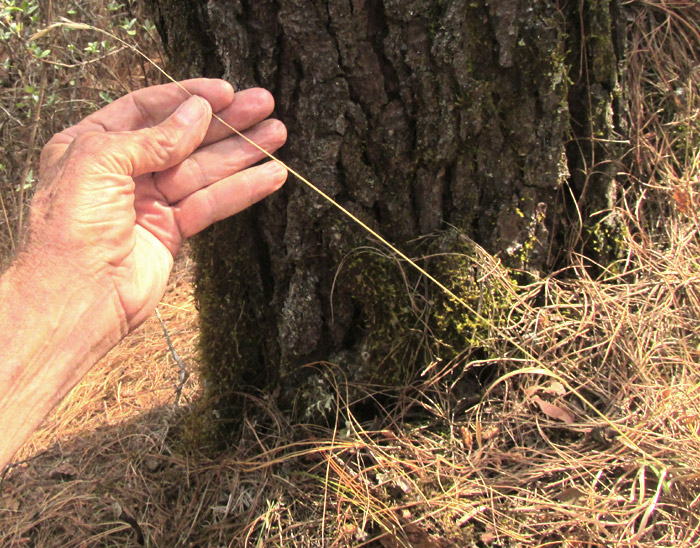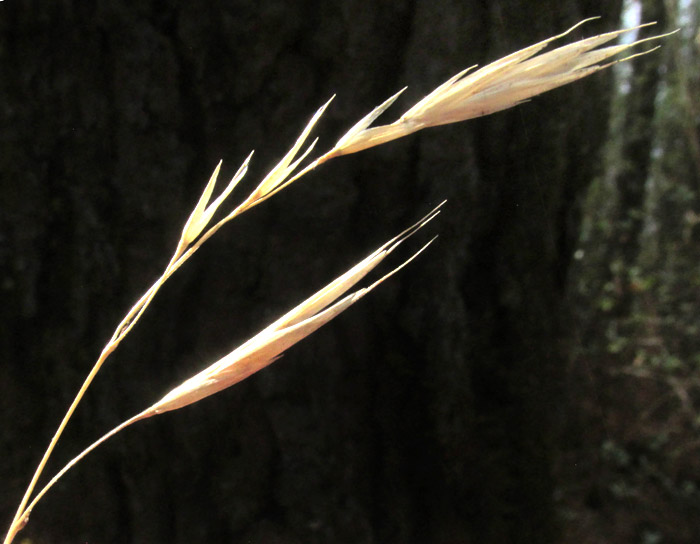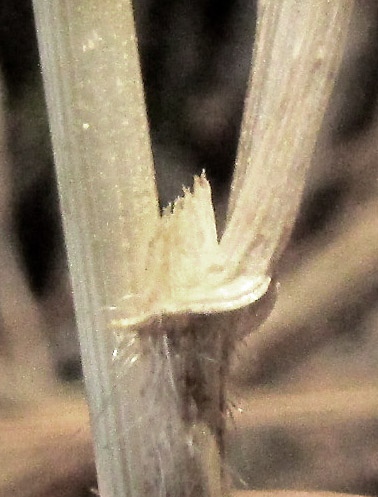Excerpts from Jim Conrad's
Naturalist Newsletter
Entry dated April 19, 2024, from notes taken about 1.5km northeast of Puerto de los Velazquez, Municipality of Pinal de Amoles; N21.138°, W99.667°, elevation ~2820 meters (~9220 feet); oak/pine/fir forest on limestone bedrock; in the Eastern Sierra Madre Mountains of east-central Querétaro state, MÉXICO
MOUNTAIN BROME

At the base of a pine tree growing on a steep, forested slope, the above past-mature grass emerged from a dried carpet of dropped pine needles.

The branching, panicle-type inflorescence had already lost most of its caryopses-bearing spikelets and florets. Some of what remained consisted of just two glumes atop long, slender pedicels, but a few spikelets containing florets remained. I bet that the remaining empty glumes help the wind shake remaining florets from their spikelets.

Above, two spikelets show that the florets' lemmas bore at their tips needlelike awns averaging 4-5mm long. Note that the awns don't arise exactly at the lemmas' tips, but rather between two short, sharp-pointed lobes. In this part of highland central Mexico, if we have a non-woody grass with spikelets on long, slender pedicels and arrayed in loose panicles, the glumes are shorter than the lemmas, and each awn arises between a lemma's cleft tip, we should think of the big "genus Bromus," the brome grasses.

At the right, a conspicuous, papery ligule arises where a leaf blade meets the stem. The ligule's top margin is cut into numerous tiny teeth; it's "lacerate."
Currently there's no flora helping with the identification of brome grasses of upland central Mexico north of Mexico City, but there's as excellent 2014 study by Jeffery Saarela and others entitled "A taxonomic revision of Bromus (Poaceae: Pooideae: Bromeae) in México and Central America." That study accepts 22 Bromus species occurring in Mexico and Central America, of which twelve are native and ten are introduced.
In Mexico and Central America, if your Bromus spikelets are flattened from the sides like ours, and the awns are around 4mm long, the longitudinal nerves on the lemmas are not well defined and easily visible, and the upper glumes are shorter than the lemmas on the lowermost floret, you have BROMUS CARINATUS.
In the US, Bromus carinatus usually is named California Brome, though the species is much more widely distributed throughout western North America, Mexico, Central America, Europe, Japan, and spottily elsewhere, than just in California. Sometimes the species is known as Mountain Brome, and that's what I'm calling it.
One reason I like that name is because Bromus carinatus is most likely to be confused with the closely related Bromus catharticus, which tends to occur in more arid, disturbed places, while our Bromus carinatus likes moister meadows, pastures and wooded slopes at higher elevations. You can compare our spikelets' obscure glume and lemma veins with those on the similar Bromus catharticus. Another very similar species, Bromus arizonicus, bears upper glumes about equal in length to the lowermost lemma, not shorter as with our plants.
The Bromus carinatus page at the Malezas de México website (Mexican Weeds) says that in Mexico our grass is used in vegetation restoration programs and to control erosion, plus it's eaten by domestic animals. It further says that in the US it's considered one of the most important forage grasses in the western mountains, and that indigenous people in both the US and Mexico have been reported using the seeds as food. Those wanting to sow Bromus carinatus seeds are advised to collect them directly from nearby populations, instead of buying commercially available cultivars, because the species is very variable.
With regard to that variability, it's interesting to note that in the 2014 revision by Saarela and others it's said that the three very similar species mentioned above form a taxonomic complex. The complex includes plants known as B. catharticus, native to South America, which are hexaploid (each cell containing six sets of chromosomes instead of the normal two); B. arizonicus, native to North America, which is duodecaploid (containing ten sets of chromosomes), and; our B. carinatus, native to North America, and which is octoploid (eight sets of chromosomes). Moreover, it's written about our grass that " Recent genetical and morphological study of the B. catharticus complex supported recognition of two polymorphic species;" our "species" actually appears to be two. As the authors say, more work is necessary to understand the B. carinatus concept.